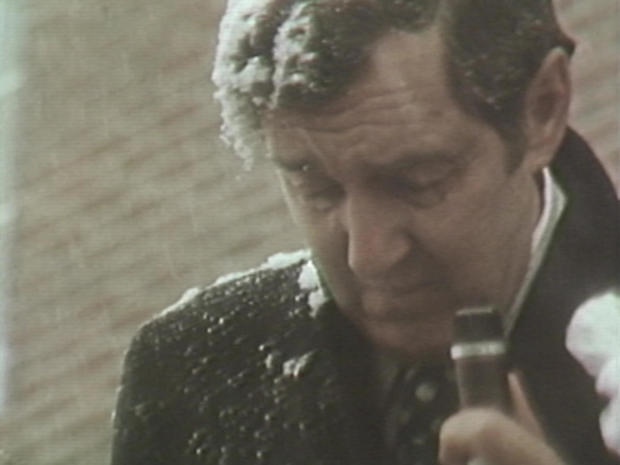Yes, it’s OK to cry
[ad_1]
For professional golfer Rob Labritz, the sport is a game of passion. And he has paired that passion with a lifetime of practice, with every day devoted to putting, chipping, pitching, bunker play, half-swings, quarter-swings, full-swings.
Which is why last December, when he finally reached a moment 35 years in the making – earning a place on the PGA Champions Tour, where the world’s best golfers 50 and over play for millions of dollars – he was speechless. Tears did all his talking.
PGA
“It was just a whirlwind of emotion, of lifelong drive and sacrifice and just practice and never-give-up,” Labritz told correspondent Jim Axelrod.
Overnight, Rob Labritz and his emotion went viral.
Axelrod asked, “How were those tears received by everyone you came in contact with?”
“I’ll say 9 million positives, and one made fun of. Just one!”
A far cry from half-a-century ago, when presidential candidate Ed Muskie’s apparent tears after a newspaper’s attack on his wife torpedoed his presidential campaign.
CBS News
“You know, if I can’t show emotion in that instance, then I guess the conclusion is that I’ve gotta be an iceberg all of the time,” Muskie said afterwards.
For Labritz, the way his tears were received reflects not just acceptance, but affirmation.
“Does it feel to you that kind of reaction reflects some sort of evolution in our culture?” Axelrod asked.
“Yeah, I mean, as things evolve, as they have in the past, what, I would say 50 or 60 years, I mean, it’s okay to cry,” Labritz replied. “Doesn’t mean you’re weak by any means. Trust me!”
Vassar psychology professor Randy Cornelius has made a 45-year scholarly study of crying, coinciding with this cultural shift from “real men don’t cry” to a 2016 poll in which 89% of Americans think it’s acceptable for men to cry.
Axelrod asked, “If Ed Muskie was running today and cried for the same reasons, would it cripple his campaign?”
“No,” Cornelius replied. “I think it would have influenced voters to see him as a more human person.”
Since Muskie, everyone from politicians to athletes has grown more comfortable shedding tears publicly.
“You must feel, since you’ve been studying this for four decades, a sense that we’re moving in the right direction as a culture if we can more readily cry?” asked Axelrod.
“Yes, I think crying is so important to us as humans,” Cornelius said. “It’s one of the things that distinguishes us as humans.”
Monkeys, dogs, horses, reptiles and birds all shed tears. But only human tears have been linked conclusively to emotion. Cornelius said, “Elephants mourn – you know, that whole thing about elephant burial grounds is true.” But they don’t tear as part of their mourning.
“So, crying as linked to emotion is uniquely human?” asked Axelrod.
“Yes.”
For Cornelius, tears have evolved as a way for humans to signal each other and mark behaviors that will help us survive – an evolutionary advantage: ” I think it perpetuates the species, because it helps in that bonding process. Tears are one of the most powerful ways in which we bond with one another. That tells us that this is a special moment, this is deep. This is existential, if you will.”
Maybe it’s the outgrowth of a change that started with tough guys like Marlon Brando crying on screen in the 1950s, that led to football stars like Rosey Grier delivering groovy permission to cry in the 1970s.
Rosey Grier sings “It’s Alright to Cry (it’s gonna make you feel better!)” from “Free to Be … You and Me” in 1972:
Psychologist Lubna Somjee has certainly seen an uptick in crying, especially with men. “I think I’ve noticed an increase in it probably in the past ten years or so,” she said. “We still sort of buy into the fact that men shouldn’t cry and men should be stoic. That being said, what’s interesting, at least in my practice, if, let’s say, 80% of women in my practice have cried at some point during therapy, I would say that 80% of my male patients have also cried.”
But acting coach Tim Martin Crouse, who once taught a 13-year old Claire Danes to cry for a scene in “Law & Order,” wants to be clear about the limits of tears. When asked how an actor learns to cry on command, he said, “Well, that question sort of treats actors like a trained seal – like, you know, flip a fish and they do their trick.”
Tears are not some sort of emotional holy grail. For Crouse, they are one way to show connection to an underlying emotion, like how Sally Field cried in “Steel Magnolias.”
One way, but not the only way.
Crouse said, “When my father died, at the funeral one of my really good friends said to me, ‘You know, I really thought you loved your father.’ And I said, ‘Uh, I did.’ They said, ‘You know, you didn’t cry.’ And I was so flabbergasted that that was their criteria for loving someone.”
“An emotional display of a certain type?” asked Axelrod.
“In public, right, and at a certain time. It doesn’t mean [by not crying] I loved him less or felt the loss less.”
Lubna Somjee noted, “There’s a lot of ways to express emotions. And tears are certainly one of them. But they are not the end-all, be-all.”
Of course, if the way someone does demonstrate their emotion is by crying, well, that’s more OK now than ever. Just ask Rob Labritz.
Axelrod asked, “Other pros, other competitors, did any of them mention it?”
“A lot of ’em said I had them in tears, too, you know?” Labritz replied. “I heard that a lot: ‘I don’t even know you, and I’m tearin’ up,’ you know? Which makes me feel really cool, you know, for just hittin’ a golf ball!”
For more info:
Story produced by Amiel Weisfogel. Editor: Lauren Barnello.
[ad_2]
Source link












